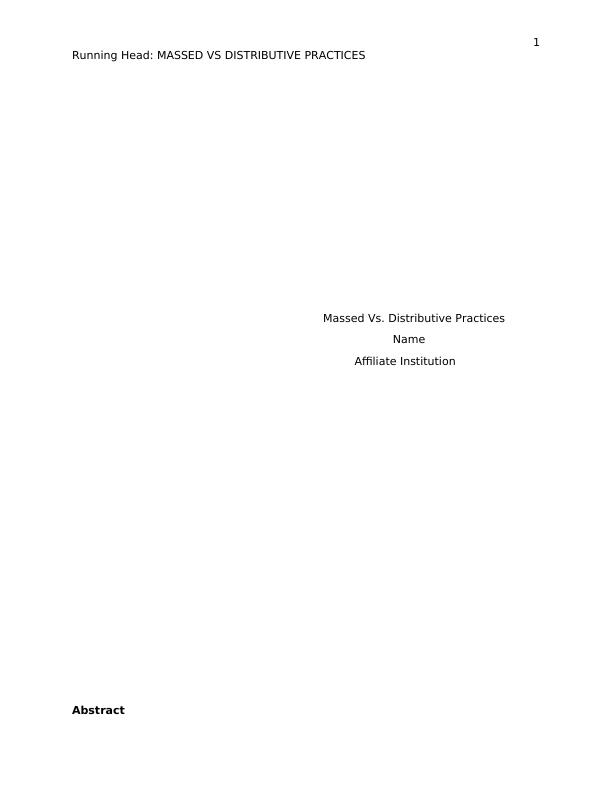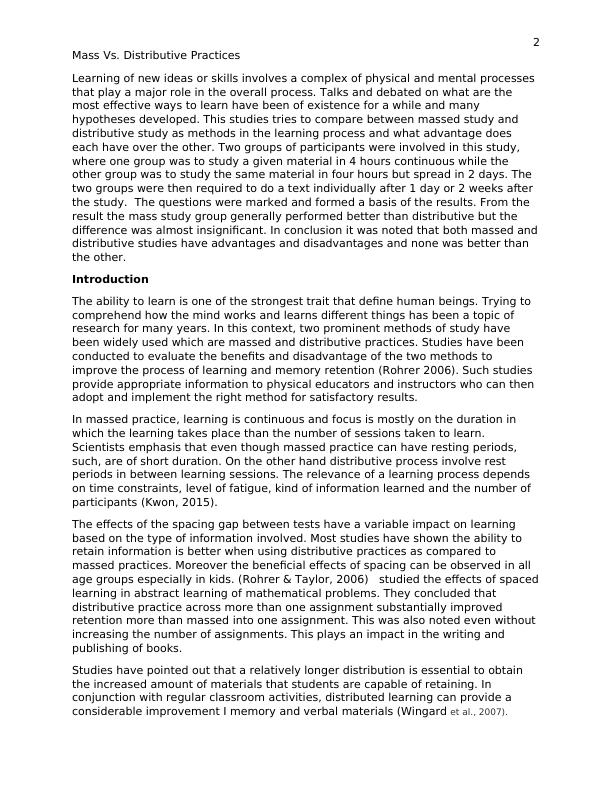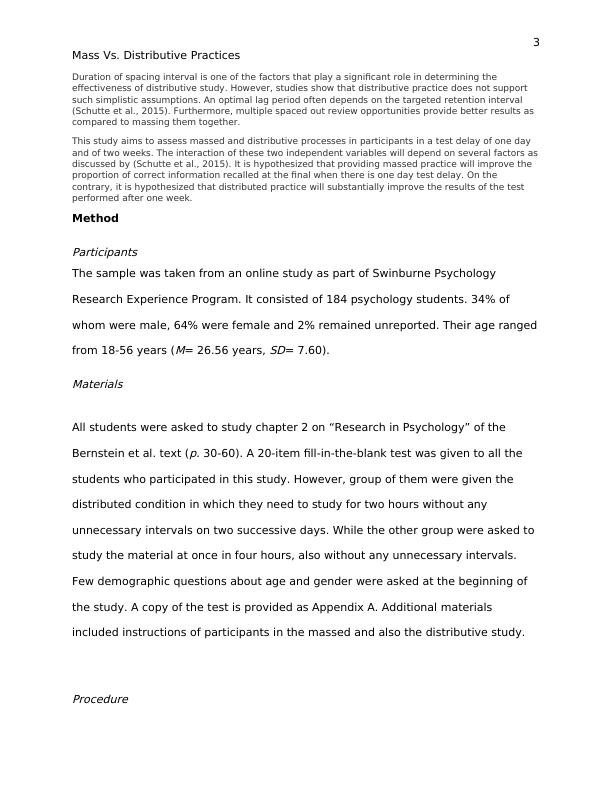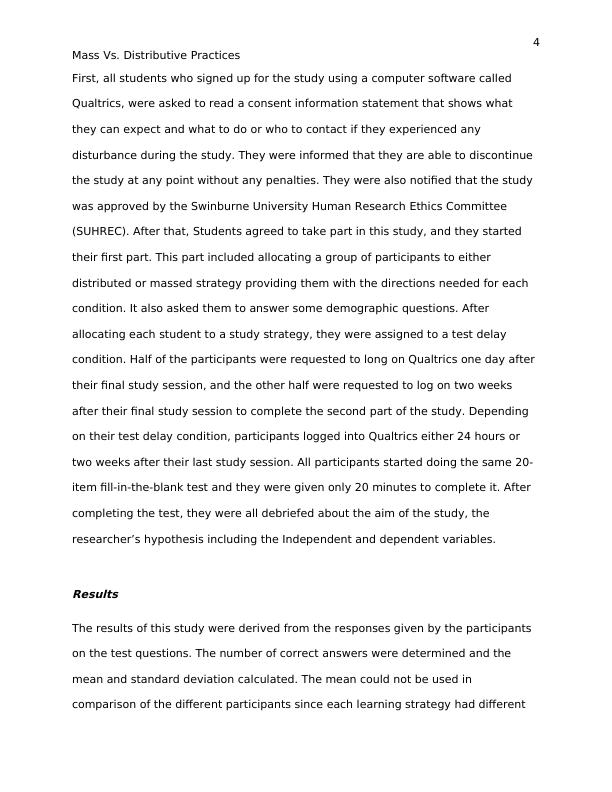Massed Vs. Distributive Practices Assignment
12 Pages3581 Words43 Views
Added on 2020-03-16
Massed Vs. Distributive Practices Assignment
Added on 2020-03-16
ShareRelated Documents
1
Running Head: MASSED VS DISTRIBUTIVE PRACTICES
Massed Vs. Distributive Practices
Name
Affiliate Institution
Abstract
Running Head: MASSED VS DISTRIBUTIVE PRACTICES
Massed Vs. Distributive Practices
Name
Affiliate Institution
Abstract

2
Mass Vs. Distributive Practices
Learning of new ideas or skills involves a complex of physical and mental processes
that play a major role in the overall process. Talks and debated on what are the
most effective ways to learn have been of existence for a while and many
hypotheses developed. This studies tries to compare between massed study and
distributive study as methods in the learning process and what advantage does
each have over the other. Two groups of participants were involved in this study,
where one group was to study a given material in 4 hours continuous while the
other group was to study the same material in four hours but spread in 2 days. The
two groups were then required to do a text individually after 1 day or 2 weeks after
the study. The questions were marked and formed a basis of the results. From the
result the mass study group generally performed better than distributive but the
difference was almost insignificant. In conclusion it was noted that both massed and
distributive studies have advantages and disadvantages and none was better than
the other.
Introduction
The ability to learn is one of the strongest trait that define human beings. Trying to
comprehend how the mind works and learns different things has been a topic of
research for many years. In this context, two prominent methods of study have
been widely used which are massed and distributive practices. Studies have been
conducted to evaluate the benefits and disadvantage of the two methods to
improve the process of learning and memory retention (Rohrer 2006). Such studies
provide appropriate information to physical educators and instructors who can then
adopt and implement the right method for satisfactory results.
In massed practice, learning is continuous and focus is mostly on the duration in
which the learning takes place than the number of sessions taken to learn.
Scientists emphasis that even though massed practice can have resting periods,
such, are of short duration. On the other hand distributive process involve rest
periods in between learning sessions. The relevance of a learning process depends
on time constraints, level of fatigue, kind of information learned and the number of
participants (Kwon, 2015).
The effects of the spacing gap between tests have a variable impact on learning
based on the type of information involved. Most studies have shown the ability to
retain information is better when using distributive practices as compared to
massed practices. Moreover the beneficial effects of spacing can be observed in all
age groups especially in kids. (Rohrer & Taylor, 2006) studied the effects of spaced
learning in abstract learning of mathematical problems. They concluded that
distributive practice across more than one assignment substantially improved
retention more than massed into one assignment. This was also noted even without
increasing the number of assignments. This plays an impact in the writing and
publishing of books.
Studies have pointed out that a relatively longer distribution is essential to obtain
the increased amount of materials that students are capable of retaining. In
conjunction with regular classroom activities, distributed learning can provide a
considerable improvement I memory and verbal materials (Wingard et al., 2007).
Mass Vs. Distributive Practices
Learning of new ideas or skills involves a complex of physical and mental processes
that play a major role in the overall process. Talks and debated on what are the
most effective ways to learn have been of existence for a while and many
hypotheses developed. This studies tries to compare between massed study and
distributive study as methods in the learning process and what advantage does
each have over the other. Two groups of participants were involved in this study,
where one group was to study a given material in 4 hours continuous while the
other group was to study the same material in four hours but spread in 2 days. The
two groups were then required to do a text individually after 1 day or 2 weeks after
the study. The questions were marked and formed a basis of the results. From the
result the mass study group generally performed better than distributive but the
difference was almost insignificant. In conclusion it was noted that both massed and
distributive studies have advantages and disadvantages and none was better than
the other.
Introduction
The ability to learn is one of the strongest trait that define human beings. Trying to
comprehend how the mind works and learns different things has been a topic of
research for many years. In this context, two prominent methods of study have
been widely used which are massed and distributive practices. Studies have been
conducted to evaluate the benefits and disadvantage of the two methods to
improve the process of learning and memory retention (Rohrer 2006). Such studies
provide appropriate information to physical educators and instructors who can then
adopt and implement the right method for satisfactory results.
In massed practice, learning is continuous and focus is mostly on the duration in
which the learning takes place than the number of sessions taken to learn.
Scientists emphasis that even though massed practice can have resting periods,
such, are of short duration. On the other hand distributive process involve rest
periods in between learning sessions. The relevance of a learning process depends
on time constraints, level of fatigue, kind of information learned and the number of
participants (Kwon, 2015).
The effects of the spacing gap between tests have a variable impact on learning
based on the type of information involved. Most studies have shown the ability to
retain information is better when using distributive practices as compared to
massed practices. Moreover the beneficial effects of spacing can be observed in all
age groups especially in kids. (Rohrer & Taylor, 2006) studied the effects of spaced
learning in abstract learning of mathematical problems. They concluded that
distributive practice across more than one assignment substantially improved
retention more than massed into one assignment. This was also noted even without
increasing the number of assignments. This plays an impact in the writing and
publishing of books.
Studies have pointed out that a relatively longer distribution is essential to obtain
the increased amount of materials that students are capable of retaining. In
conjunction with regular classroom activities, distributed learning can provide a
considerable improvement I memory and verbal materials (Wingard et al., 2007).

3
Mass Vs. Distributive Practices
Duration of spacing interval is one of the factors that play a significant role in determining the
effectiveness of distributive study. However, studies show that distributive practice does not support
such simplistic assumptions. An optimal lag period often depends on the targeted retention interval
(Schutte et al., 2015). Furthermore, multiple spaced out review opportunities provide better results as
compared to massing them together.
This study aims to assess massed and distributive processes in participants in a test delay of one day
and of two weeks. The interaction of these two independent variables will depend on several factors as
discussed by (Schutte et al., 2015). It is hypothesized that providing massed practice will improve the
proportion of correct information recalled at the final when there is one day test delay. On the
contrary, it is hypothesized that distributed practice will substantially improve the results of the test
performed after one week.
Method
Participants
The sample was taken from an online study as part of Swinburne Psychology
Research Experience Program. It consisted of 184 psychology students. 34% of
whom were male, 64% were female and 2% remained unreported. Their age ranged
from 18-56 years (
M= 26.56 years,
SD= 7.60).
Materials
All students were asked to study chapter 2 on “Research in Psychology” of the
Bernstein et al. text (
p. 30-60). A 20-item fill-in-the-blank test was given to all the
students who participated in this study. However, group of them were given the
distributed condition in which they need to study for two hours without any
unnecessary intervals on two successive days. While the other group were asked to
study the material at once in four hours, also without any unnecessary intervals.
Few demographic questions about age and gender were asked at the beginning of
the study. A copy of the test is provided as Appendix A. Additional materials
included instructions of participants in the massed and also the distributive study.
Procedure
Mass Vs. Distributive Practices
Duration of spacing interval is one of the factors that play a significant role in determining the
effectiveness of distributive study. However, studies show that distributive practice does not support
such simplistic assumptions. An optimal lag period often depends on the targeted retention interval
(Schutte et al., 2015). Furthermore, multiple spaced out review opportunities provide better results as
compared to massing them together.
This study aims to assess massed and distributive processes in participants in a test delay of one day
and of two weeks. The interaction of these two independent variables will depend on several factors as
discussed by (Schutte et al., 2015). It is hypothesized that providing massed practice will improve the
proportion of correct information recalled at the final when there is one day test delay. On the
contrary, it is hypothesized that distributed practice will substantially improve the results of the test
performed after one week.
Method
Participants
The sample was taken from an online study as part of Swinburne Psychology
Research Experience Program. It consisted of 184 psychology students. 34% of
whom were male, 64% were female and 2% remained unreported. Their age ranged
from 18-56 years (
M= 26.56 years,
SD= 7.60).
Materials
All students were asked to study chapter 2 on “Research in Psychology” of the
Bernstein et al. text (
p. 30-60). A 20-item fill-in-the-blank test was given to all the
students who participated in this study. However, group of them were given the
distributed condition in which they need to study for two hours without any
unnecessary intervals on two successive days. While the other group were asked to
study the material at once in four hours, also without any unnecessary intervals.
Few demographic questions about age and gender were asked at the beginning of
the study. A copy of the test is provided as Appendix A. Additional materials
included instructions of participants in the massed and also the distributive study.
Procedure

4
Mass Vs. Distributive Practices
First, all students who signed up for the study using a computer software called
Qualtrics, were asked to read a consent information statement that shows what
they can expect and what to do or who to contact if they experienced any
disturbance during the study. They were informed that they are able to discontinue
the study at any point without any penalties. They were also notified that the study
was approved by the Swinburne University Human Research Ethics Committee
(SUHREC). After that, Students agreed to take part in this study, and they started
their first part. This part included allocating a group of participants to either
distributed or massed strategy providing them with the directions needed for each
condition. It also asked them to answer some demographic questions. After
allocating each student to a study strategy, they were assigned to a test delay
condition. Half of the participants were requested to long on Qualtrics one day after
their final study session, and the other half were requested to log on two weeks
after their final study session to complete the second part of the study. Depending
on their test delay condition, participants logged into Qualtrics either 24 hours or
two weeks after their last study session. All participants started doing the same 20-
item fill-in-the-blank test and they were given only 20 minutes to complete it. After
completing the test, they were all debriefed about the aim of the study, the
researcher’s hypothesis including the Independent and dependent variables.
Results
The results of this study were derived from the responses given by the participants
on the test questions. The number of correct answers were determined and the
mean and standard deviation calculated. The mean could not be used in
comparison of the different participants since each learning strategy had different
Mass Vs. Distributive Practices
First, all students who signed up for the study using a computer software called
Qualtrics, were asked to read a consent information statement that shows what
they can expect and what to do or who to contact if they experienced any
disturbance during the study. They were informed that they are able to discontinue
the study at any point without any penalties. They were also notified that the study
was approved by the Swinburne University Human Research Ethics Committee
(SUHREC). After that, Students agreed to take part in this study, and they started
their first part. This part included allocating a group of participants to either
distributed or massed strategy providing them with the directions needed for each
condition. It also asked them to answer some demographic questions. After
allocating each student to a study strategy, they were assigned to a test delay
condition. Half of the participants were requested to long on Qualtrics one day after
their final study session, and the other half were requested to log on two weeks
after their final study session to complete the second part of the study. Depending
on their test delay condition, participants logged into Qualtrics either 24 hours or
two weeks after their last study session. All participants started doing the same 20-
item fill-in-the-blank test and they were given only 20 minutes to complete it. After
completing the test, they were all debriefed about the aim of the study, the
researcher’s hypothesis including the Independent and dependent variables.
Results
The results of this study were derived from the responses given by the participants
on the test questions. The number of correct answers were determined and the
mean and standard deviation calculated. The mean could not be used in
comparison of the different participants since each learning strategy had different

End of preview
Want to access all the pages? Upload your documents or become a member.
Related Documents
Mass Practice vs Distributive Practice Learning Techniqueslg...
|13
|2773
|29
PSY10004: Psychology Lab Reportlg...
|5
|1154
|533
Effect of Distributed Practice vs Massed Practice on Learning: Lab Report Assignmentlg...
|15
|3717
|222
Massed vs. Distributed Practice in Learning and Memorylg...
|11
|2761
|148
Effect of Massed Practice vs Distributed Practice on Test Performancelg...
|11
|2602
|441
Effect of Distributed vs Massed Learning on Memory and Recalllg...
|11
|2858
|144
